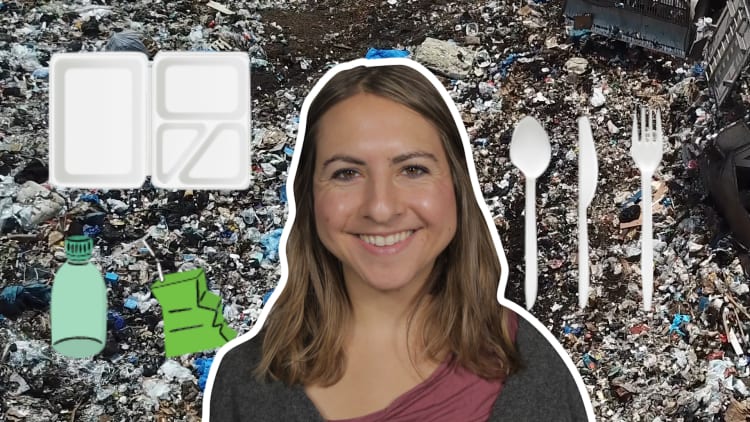Many of the most important money habits are built over time: Saving, investing and cutting back spending, among others. Those aren't short term goals, but rather long term solutions. Still, there are plenty of things that can be accomplished in a year's time that can make a major difference in your life.
Here are six simple financial tasks you can tackle in 2020 that will pay dividends for years to come:
1. Track your spending for one month
This financial task seems basic, but it's key to figuring out where your money is going and how you might be able to better allocate it.
As you're logging your expenses, categorize them in a way that makes sense to you (bills, food, transportation, eating out, entertainment, etc.). At the end of the month, calculate the total you've spent in each of your categories. It will become obvious where you can cut back spending, if you need to, or where you should direct more money. For more advice, read this article.
2. Start taking privacy and online security seriously
With the countless data breaches and financial scams transpiring on a near daily basis, it's imperative to proactively protect your financial and personal data. There are a number of strategies for doing this, but some of the most basic include:
- Set alerts on your bank accounts and credit cards for suspicious activity.
- Routinely check your financial accounts and credit report for fraud.
- Use unique passwords for your financial accounts and keep a password manager.
- Do not trust anyone — whether on the phone or via email or text — claiming to be from a bank, brokerage or other financial or government institution.
- Freeze your credit reports if you will not need to access them in the short term and opt into a credit monitoring service.
Nothing will keep you 100% secure, but making it even slightly more difficult for someone to scam you will encourage them to move on to an easier mark, security experts say. And remember, securing your finances and personal data isn't something you can do once and then forget about; it should be an ongoing concern.

Check out these articles for more security tips.
3. Improve your personal savings rate
Your personal savings rate is the amount of your disposable income you do not spend in a given time frame.
You can determine it for 2019 using the following steps:
- Calculate your income for the year
- Calculate your saving for the year
- Divide your savings by your income
- Multiply by 100 for a percentage
That means if you take home $3,000 per month and save $300 between retirement, your savings account and other funds, your personal savings rate is 10%.
Remember, your savings figure should include any contributions to your savings account, retirement accounts, health care savings accounts, including an FSA or HSA, 529 plans and any other investments. The figure won't be perfectly exact because 401(k) contributions, for one, are made pre-tax, but it's still a worthwhile exercise.
Once you know your savings rate, aim to increase it by at least one percentage point in 2020. Then, increase your automatic contributions by 1%, or to whatever your goal percentage is, and track your progress throughout the year. Experts recommend saving 20% of your monthly income, between retirement and other goals.
4. Increase your credit score
Improving your credit score can help you secure lower interest rates on credit cards, auto loans and even a mortgage. If you're planning to open a new card, or want to buy a house one day, improving your credit score can save you, potentially, thousands to tens of thousands of dollars over time.
First things first: Pull your credit report. You can pull your report for free once a year from each of the three main credit bureaus: Equifax, Experian and TransUnion. Once you do, you can get a better sense of the story your credit is currently telling: Have you missed a lot of payments? Do you have old, overdue accounts you forgot about? Your report will tell you. It lists all of your credit inquiries, all of your credit accounts, how long they've been open and your payment history.

That knowledge will help inform the steps you can take to improve your credit over the next 12 months. The most important thing you can do is pay off your bills on time and in full, which accounts for the largest portion of your credit score. If you've been tracking your spending, you will be able to spot easy things to cut out to ensure that your bills remain in your budget.
After that, the amount you owe is the most important factor. The less money you have on credit at any one time, the better, but credit experts say to aim to use no more than 30% of your credit limit. If your credit limit across accounts is $10,000, you want to charge no more than $3,000 total at one time.
Experts say a score of 750 or higher will typically qualify you for the best offers (your FICO score ranges between 300 and 850); once you hit 750, there's no need to obsess over increasing it any more.
For more on improving your credit score, check out this article.
5. Have better conversations
If you have a partner, schedule a time to talk through your financial goals, worries and strategies. Being open and honest about money will bring you closer together, and, ideally, prevent any anger or frustration around your shared finances from building.
Talking with a trusted friend or coworker, especially one who seems to know a bit more about money than you, can also be enlightening. They might be able to give you solid advice, or offer encouragement. Discussing salaries with coworkers, when done prudently, can give you a better idea of if you are being compensated fairly.
For tips on how to talk about money with friends or family, read this article.
6. Think sustainably
Practicing sustainability is good for the planet and your bank account. If you scale back how much you're buying overall, you'll save money. Similarly, buying sustainably-made products that can be reused over and over, instead of one-time use items, can also save you over the long term.

The most sustainable product is the one you don't buy. That said, replacing a few products with a sustainably-produced version, like beeswax wrap in lieu of plastic wrap or shampoo and conditioner bars, can help you build more sustainable habits over time.
Again, you'll want to use up what you already have — throwing away perfectly usable Ziploc bags to use a more environmentally-friendly option won't help anything — and while doing so, save for the larger up-front expenses of sustainable products. Then, when it's time to replace the items you've used up, you'll have the money you need.
Don't miss: I committed to a 'no-spend summer.' Here's how it changed my relationship to money
Like this story? Subscribe to CNBC Make It on YouTube!



